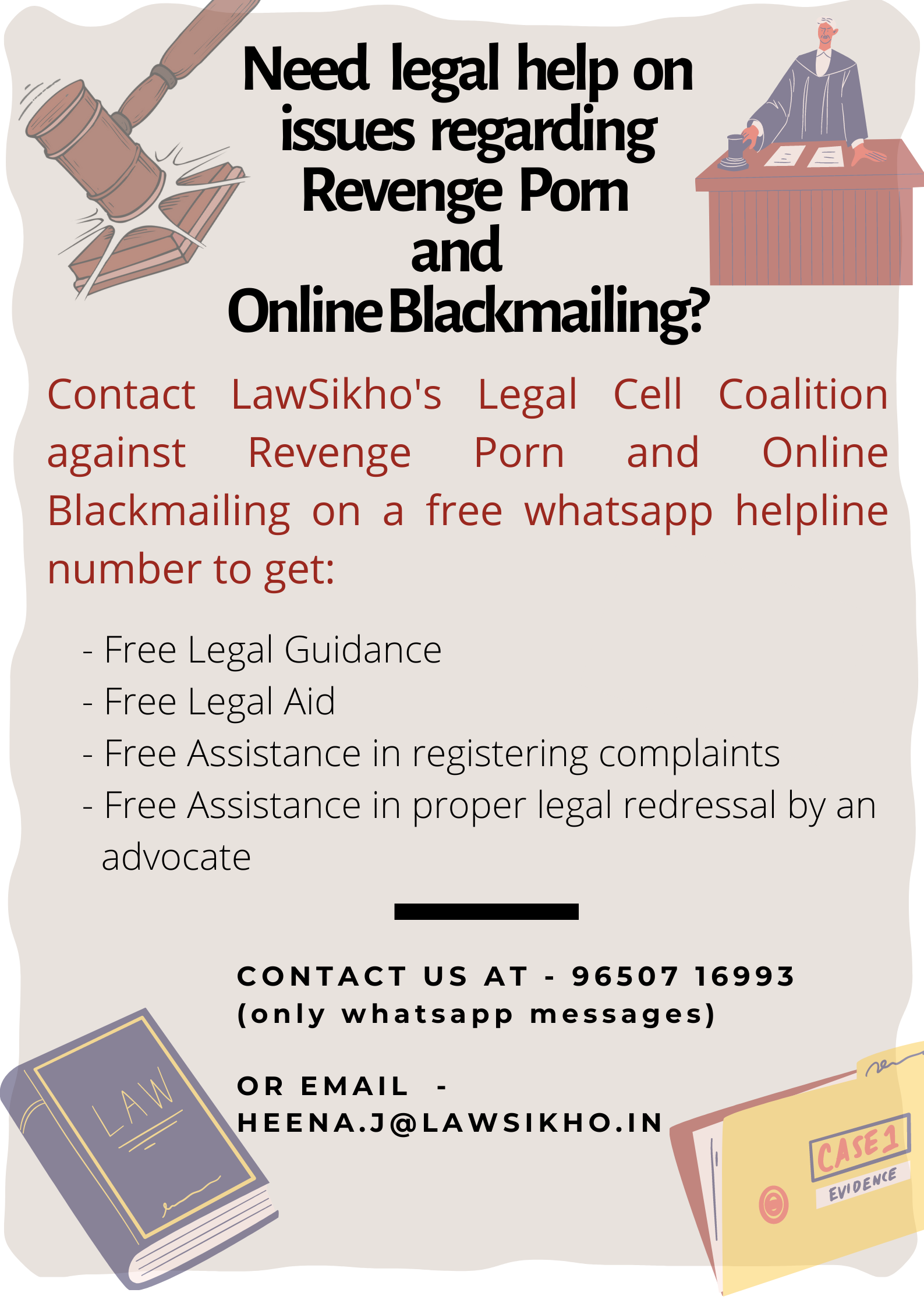This article has been written by Khushi Ahuja, from Vivekananda Institute of Professional Studies on revenge porn and the ways to prevent it along with legal support offered to the victims with the help of cases.
“It made me feel like I was dirty and just the fact everyone has seen me just made me feel violated and it knocked my confidence so much. I didn’t go out for ages, I just thought everybody knew because everybody did know and I didn’t report it to anybody. I didn’t report it to the police because I thought I was in the wrong, I took the picture.” – revenge porn victim
Table of Contents
What is revenge porn
The act of sharing or publishing explicit and private sexual images, videos and materials of another person without their consent to cause shame, embarrassment, harm or distress by a former partner is known as Revenge porn.
The Merriam- Webster dictionary defines revenge porn as the “sexually explicit images of a person posted online without that person’s consent, especially as a form of revenge or harassment.”
It is an unethical practice of pornography that has gained international attention in recent years due to multiple cases and incidents. Sometimes the leaked images and video contain the private information like name, address and links to the social media handles by the avenging ex-lovers who use this method offline or online to take revenge. The issue is not only limited to adults but children as young as 11 years of age who are in their teens up to their mid-twenties.

The essential ingredients of revenge porn are –
- The perpetrator and the victim used to share an intimate relationship.
- The perpetrator has deliberately and without the consent of the victim released sexually explicit videos and photographs online to cause distress and harm to the victim’s reputation.
Many studies suggest that this act is not limited to just vengeance of the ex-lovers but is also being used for blackmail, stalking and sexual harassment.
A study lead author, Anastasia Powell from RMIT in Australia said that “We found that image-based sexual abuse is used by perpetrators of domestic violence and sexual assault in stalking and sexual harassment, as well as in threats and bullying by peers and other known people. Not only this, but we found high numbers of victims had never consented to have their image taken,”.
Case study
The state of West Bengal vs. Animesh Box
A landmark case in March 2018, the sessions court in Tamluk, West Bengal decided a case on Revenge porn and provided justice to the victim.
A 23-year-old man was in an intimate relationship with the victim. On the promise of marriage, he obtained private and sexual images from the victim. When the victim broke off the marriage, the accused uploaded the explicit material on porn sites to blackmail her into getting back with him with the sensitive details of the victim and her father.
The Court in East Midnapore district ruled in favour of the victim and sentenced the man to 5 years of imprisonment along with a fine of Rs. 9000. The accused was convicted under Sections 354A, 354C, 354 and 509 of the Indian Penal Code, as well as Sections 66E, 66C, 67 and 67A of the Information Technology Act.
The case stood out for another reason, i.e the court ordered for the 20-year-old victim to be treated as a rape survivor and to be provided with appropriate compensation.
According to Adv. Bivas Chatterjee, the Public Prosecutor in this case, “98 percent of cyber-crime victims do not even complain as the victims, who are usually women, fear they will get identified and labelled in society. Hence along with the legal and logistical issues, prosecution for the crime is also affected by the lack of reporting of such incidents.”
Revenge porn kingpin
This was one of the best-known cases of revenge porn which was started by Hunter Moore, the most hated man on the internet with a website named IsAnyoneUp.com in 2010. This website was a platform to be used to feature explicit, sexual and obscene material along with tagged sensitive information of the victim. The victims claimed that these pictures and videos would have been released by their ex-lovers who were seeking revenge or were trying to blackmail them. Some even claimed that their cellphones and computers were hacked to retrieve the information. Charles Evans, a partner to Hunter Moore, was paid to hack these devices and accounts. The FBI in 2014 charged Moore on 15 accounts and offences to which he later pleaded guilty while receiving imprisonment of 2-7 years with $2000 as a fine.
Legal support to the victims in India
Cases of revenge porn have seen a rise in many countries around the world, which already is infected by multiple forms of crimes and sexual violence against women. Digitalization has given rise to technical power giving a larger breeding ground for such offences and abuse in the virtual world too. The rise of cybercrimes and lack of appropriate laws have made it difficult to regulate the crimes. India doesn’t have any specific laws to deal with revenge porn but various acts like the Indian Penal Code and Information Technology Act have given leverage to the victims who claim justice.
Breach of privacy
The consent for capturing of sexual/obscene images remains immaterial so long as the publication of such material was done without the consent of the person in the pictures or videos. It doesn’t matter if the captured material was mutually consented and permitted, the release without the consent leads to a breach of privacy and is punishable under the law.
Information Technology Act
- Section 66E: This section in the Information Technology Act of 2000 provides for the punishment for violation of privacy wherein the accused intentionally captures, publishes or transmits the picture or image of the victim’s private body part without the permission or consent of the individual. Such perpetrator of the offence is to be punished with imprisonment which may extend up to 3 years or a levied fine not exceeding 2 lakh rupees, or in some cases both.
- Section 67: This section provides for the punishment for publication of or transmission of obscene and sexual material through an electronic medium. The person accused would be liable and convicted with imprisonment up to 3 years or a fine of 5 lakh rupees and in the event of a second offence, a term of 5 years with a fine up to 10 lakhs.
- Section 67A: Publication of obscene material through the electronic form can lead to imprisonment up to five years with a fine which may extend to ten lakh rupees and in the occurrence of a second conviction, imprisonment of seven years and with fine which may extend to ten lakh rupees.
- Section 67B: This section talks about the publication of sexual and obscene content featuring a child. Such a person can be convicted up to 5 years with a fine of 10 lakhs for committing the offence.
Indian Penal Code 1860
- Section 354: This section in The Indian Penal Code 1860 defines the criminal force or assault on a woman to outrage her modesty. If a person commits such an offence, he/she will be liable for imprisonment up to 2 years or fine or both.
- Section 354A: According to section 354A of Indian penal code, A man who advances unwelcome and sexual physical contact, asks for sexual favours, forces a woman to watch pornography or makes sexually coloured remarks and statements will be guilty of sexual harassment. The person shall be punished with rigorous imprisonment up to 3 years or with a fine or both.
- Section 354C: This section explains the act of Voyeurism. According to this section, if any man watches or captures a woman engaging in a private act, unaware she is being watched or filmed, not expecting of being observed by the person who disseminates such image or video would be liable under the law with conviction and imprisonment, not less than 1 year which can extend up to 3 years along with a fine. On a second conviction, the person might be imprisoned for 3 years along with fine.
- Section 406: This section comprises the punishment for criminal breach of trust i.e imprisonment up to 3 years with fine or both.
- Section 506: It provides for the punishment of criminal intimidation where the accused will be punished with imprisonment up to 2 years or a fine or both. If the accused threatens the victim with death, grievous hurt or destruction of property or to impute, unchastity to a woman, shall be punished with imprisonment up to 7 years or fine or both.
- Section 509: This section talks about the punishment of a man who tries to insult the modesty of a woman by words, gestures, sounds or object, intending for it to be seen or heard, intruding the privacy of the woman. Such a person will be punished with imprisonment up to 1 year or fine or both.
- Extortion, harassment, revealing the victim’s name, etc. attract laws on defamation and criminal intimidation under Sections 400 and 506 of the IPC.
Prevention
The internet today has provided a vast platform for people to retrieve as well as upload information. This has given way to advantages as well as disadvantages involving criminal activity as it allows people to anonymously access information and commit offences while hiding their identity. Internet-related crimes like cyber harassment, cyberhacking, cyberstalking and cyberbullying have seen a major rise in numbers.
Revenge porn, today is one of the most impactful offences a perpetrator has at hand. It not only impacts mental health negatively but also damages relationships and the victim’s social reputation leading to isolation. Thus the need of the hour is to take steps to prevent the incidents of revenge porn –
- By far the best way to prevent the publication of any images that are obscene or private is their non-existence in the first place. Sharing such images to anyone is always a risk which leads to such incidents. Moreover, the pictures on the phone and computer can be leaked through hacking. Never share your intimate pictures online.
- Installation of security software on the computer and mobile phones can be a big help. It creates a barrier and hindrance from backing and leakage of information.
- Always protect your devices and computers with a strong password.
- One should never give out their passwords to other people. A person might be trustworthy at first but can use images and videos for wrong purposes later.
- One should never be afraid to ask for deleting the pictures and make sure they are being deleted by keeping a close watch.
- Awareness programs, parents and schools should inculcate and educate the children about the mishaps and the risks of sexting.
- If you are not comfortable with taking any such pictures or videos, one should deny to do the same and not shy away, in extreme cases inform parents about the force or pressure being applied to receive the picture. Never give in to coercion.
- It is always safe to check the surroundings while at clubs, hotels etc. and protect oneself from any tragedies by ensuring that no one around is filming or clicking inappropriate pictures or videos.
- Monitor your online presence carefully to ensure your cyber presence is valid.
- There should be a propagation of laws that particularly deal with the issue of revenge porn.
- The laws made should be gender-neutral and should ensure equal protection to men too.
Conclusion
If any such incident happens, the websites deal with the issue of copyright claims more quickly than the legal processes. Thus, the victim should use this method to stall the further damage and publication. The law is not as effective and quick in this case and needs regulation to provide speedy justice to the people. The impact of such incidents can be long-lasting and according to experts, the mental trauma is equivalent to that experienced by a victim of sexual harassment. Thus, the victims need justice and redressal to their loss in the best possible way.
References
- https://bnblegal.com/article/revenge-porn-in-india/
- https://www.timesnownews.com/mirror-now/in-focus/article/revenge-porn-how-it-destroys-lives-and-how-to-deal-with-the-menace/550397
- https://www.pandasecurity.com/mediacenter/security/security-tips-revenge-porn/
- https://vpnoverview.com/internet-safety/cybercrime/revenge-porn/
- http://jaapl.org/content/44/3/359
- https://www.firstpost.com/tech/news-analysis/new-laws-for-revenge-porn-to-be-introduced-we-have-a-look-at-some-of-the-required-changes-3703905.html
LawSikho has created a telegram group for exchanging legal knowledge, referrals and various opportunities. You can click on this link and join:
 Serato DJ Crack 2025Serato DJ PRO Crack
Serato DJ Crack 2025Serato DJ PRO Crack











 Allow notifications
Allow notifications



